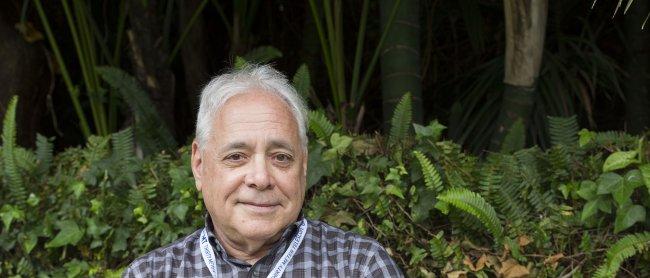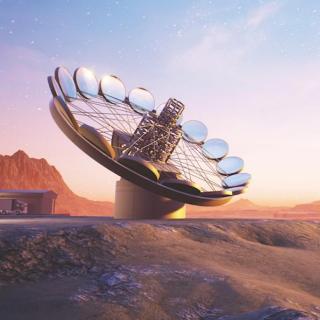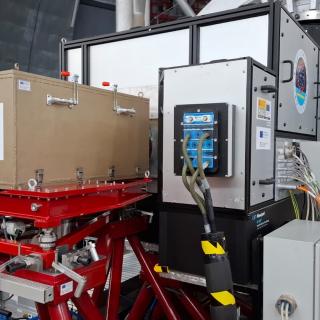“There are two reasons for building a telescope with a 30 meter diameter” says Gary Sanders, of the California Institute of Technology (CALTECH), the project manager of the Thirty Meter Telescope (TMT) project. “A large diameter allows us, in the first place, to collect more light, and in the second place, to obtain a sharper image. But,” he warns, “this is possible only if the distortions produced by the Earth’s atmosphere are corrected, so that the telescope needs Adaptive Optics. Once we have more light, and a sharper image we can separated objects which are very close together in the sky, we can see structures in greater detail, and detect the things we are looking for. Maybe we will even be able to image exoplanets. So Adaptive Optics is very important”.
The TMT will use a system of Multi-Conjugate Adaptive Optics (MCAO). This is what brings Gary Sanders, together with other members of the TMT team, such as Corinne Boyer, Christophe Dumas, and Gelys Trancho, to the conference on “Adaptive Optics for Extremely Large Telescopes (AOELT5) which is taking place this week at the Hotel Botánico in Puerto de la Cruz, Tenerife. For Sanders, this type of conferences, which bring together scientists and technical staff, some 300 specialists on this occasion, are necessary to interchange experiences and to establish common ground between the astronomy and the engineering which affect the five projects for extremely large future telescopes, the solar telescopes DKIST and EST, and the night-time telescopes GMT, TMT, and E-ELT, as well as present day telescopes such at the Gran Telescopio Canarias (GTC).
The MCAO system measures the turbulence at different heights in the atmosphere and makes a model to correct the distortion that this turbulence produces in the observed image. To do this deformable mirrors are used. “Our Adaptive Optics system” explains Sanders “is being designed by our Canadian partners in Victoria (British Columbia). Some of the components will come from around the world. And that will be our basic Adaptive Optics system. We are also thinking of adding a secondary mirror with Adaptive Optics to the telescope.
Adaptive Optics techniques will be a determining factor in astrophysical research in the future with extremely large telescopes such as the TMT. Sanders comments that one of his favourite astronomical interests is the possible detection of signatures of life outside the Earth. “I am sure that the TMT will be a good competitor in that search. Even if we don’t turn out to be the first to detect such signatures, we can give a great deal to this field”. Nevertheless,” he adds, “I am most interested personally in solving problems related to dark matter and dark energy. I think that the TMT will be a very powerful tool in that area”.
Countdown
Gary Sanders is, as he himself describes it, “the project manager of the TMT, which means the person in charge of the team which designs the telescope, builds it, commissions it, and delivers it in working order to the six participating members of the project in order to do astronomy”. The present members of the TMT are Canada, China, India, Japan, CALTECH and the University of California.
Sanders reminded us that Hawaii was the original site planned for the TMT, but problems have arisen with the indigenous population, who have objected to the development of astronomy on Mauna Kea Mountain. The Hawaiian site was chosen because it is a high and dry mountain, which are two advantages for astronomy. “We are currently working with the authorities there to try to resolve these problems. If we keep on encountering obstacles to placing it on Hawaii we would be very happy to build it in the Canaries. With the TMT on La Palma we could do marvelous astronomy”.
But we will still have to wait at least six months to know the final site fo the TMT. Sanders explains that it is necessary to finish the legal process. “We are also carrying out legal processes here, in the Canaries. We have published an environmental impact evaluation and a document which has been reviewed by the Government of the Canaries to requalify the land use of the terrain in the municipalities of Puntagorda and Garafía. It seems that the key moment to take the decision will be towards the end of this year or early in 2018. “In any case,” he adds, “we would like to re-start the building process in April 2018”.
It is hoped that the TMT and the IAC will maintain a close collaboration. “In the first place” says Sanders “we have agreed with the IAC to sign an agreement on scientific instrumentation, and we hope to do so. We have many plans, and it will be very good to work with the scientists at the IAC. We are also beginning to hold conversations on scientific instrumentation on a larger scale. Perhaps the secondary mirror with Adaptive Optics for the telescope, and in other technical areas, although we are still at an early phase of the negotiation. If, finally, we do come here, we hope to be real partners”.
Related press releases:



